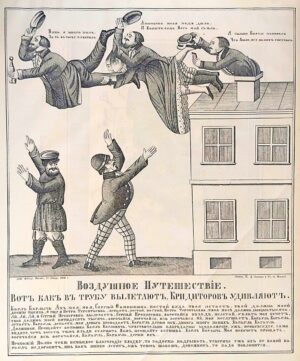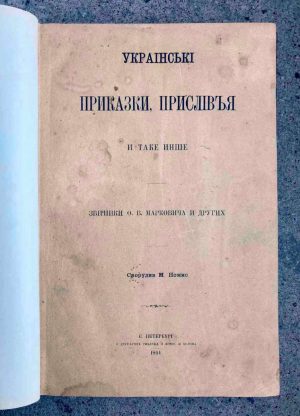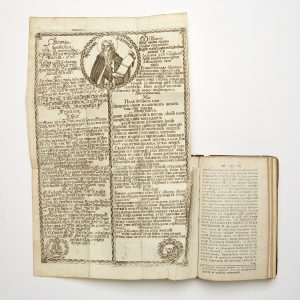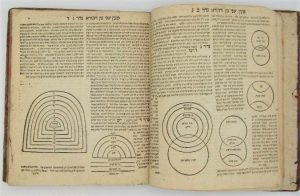Our Notes & References
Exhaustive collection of striking, informative, curious and amusing popular Russian prints following the Russo-Turkish and Caucasian wars, but also covering a large variety of subjects in a very graphic way.
Rare: we could find only two copies of this album sold in 1975 and 2008 (the latter missing a plate); Worldcat locates only two physical copies (Indiana University, BnF).
The so-called lubok, or popular folk prints, appeared in Russia in the early 17th century and quickly became popular with peasants and urban lower classes for their accessible anecdotic images and narratives on a broad variety of themes. Sometimes reprinted many times over the years, they would often decorate peasants’, merchants’ and bourgeois’ houses and even replace icons, books and newspapers.
The successful publisher and educator Ivan Sytin (1851-1932) was one of the largest producers and distributors of printed lubok in the second half of the 19th century; he presented his prints at various exhibitions, including the All-Russian Art and Industry Exhibition in Moscow (1882) where he received a silver medal. Usually sold individually, the prints were rarely gathered in bound volumes by the publisher, and the present album of 85 large-format plates was most likely published for a similar exhibition abroad. Some of the lithographs are by V. Vasiliev, another publisher of lubki in Moscow in the late 1880s.
Most of these pictures were created before 1860 but were widely reprinted over the later decades. They cover a very wide range of themes, even if the military events are represented in majority.
Some expansive and complex perspectives illustrate folk tales about mighty bogatyrs Ilia Muromets, Eruslan Lazarevich, Ivan Tsarevich, Bova Korolevich (whose legend was referenced in Pushkin’s Tale of Tsar Saltan) and the brave Anika the Warrior — the plate showing Anika’s confrontation with death was also in the lubok collection of the prominent Russian avant-garde artists Natalia Goncharova and Mikhail Larionov.
Some great images depict anecdotic moments, such as a drunken fight in a tavern, a dentist pulling out a tooth, city festivities on Maslenitsa, debtors escaping from money lenders through chimneys, and a song about a wife who drank too much beer and forgot to cook for her husband – as well as lyrical and tragic scenes: a young bride arriving in the husband’s evil family or a woman abandoning her child by the strangers’ house. The album also includes the humorous scene of mice at a funeral procession of a cat – one of the most popular lubok pictures since the early 18th century. The great collector and art historian Dmitrii Rovinskii suggested that the scene satirically represents the funeral of Peter the Great as the mice in the procession play brass instruments: such an orchestra played for the first time in Russia at Peter’s funeral.
Other lubki present popular folk songs and traditional dances, illustrate famous poems and fables by Krylov (“the Russian La Fontaine”), and portray historic characters (Conqueror of Siberia Ermak Timofeevich, Ivan Susanin, Prince Pozharskii).
Among the most curious lubki in the collection is “The Latest Card Oracle” [“Noveishii kartochnyi orakul”] designed for fortune-telling (ironically, printed without any changes after the plate from the 1850-60s). It offers predictions about money, happiness, loss, fate, travel, gossip, marriage and encourages to actions, suggests solutions to prepare and overcome negative emotions and to reduce the fear of the unknown.
A substantial part of the album is taken by images of major and relatively recent Russian military battles: they were part of an effort to inform about the main military events in the country and to keep up the patriotic spirit of the people, emphasising the courage of the Russian soldiers, such as Aleksandr Suvorov sieging Izmail fortress (1790) during the Russo-Turkish War of 1787–1792 and Ivan Skobelev at the amputation of his arm in the midst of the battle during the Polish Uprising of 1830-31.
The more recent Crimean War (1853-56) receives particular attention, on all fronts: Crimea, Caucasus and the Baltic/White Sea. The large plates show prince Vasilii Bebutov at the battle of Basgedikler, and the Cossacks visiting a Turkish mushir with a letter from victorious Bebutov; a battle near the southeastern border of Guria (region in modern Georgia) in June 1854 where Russians, Don cossacks and Georgian cavalry captured a fully equipped Turkish camp; monks and soldiers at the Solovetskii monastery repelling a British squadron in July 1854; the famous siege of Sebastopol in 1854–55 and its aftermath; Ukrainian cossack soldiers in Sebastopol discussing in a mixture of Ukrainian and Russian their wishes to defeat the Turks; the surrender of Kars after its siege in November 1855 led by General Muraviev whose troops “took captive the Turkish Mushir Commander-in-Chief of the Anatolian army Mahmed-Vasif Pasha and English General Williams with all his staff” – and a folding plate showing Mikhail Gorchakov on the battlefield. Some of the plates present common soldiers and quote their songs and anecdotes mocking the cowardice of the enemies.
The Imperial Romanov family is also represented, including Nicholas I himself at a military parade, his sons Konstantin, Mikhail and the future emperor Aleksandr, his coronation in 1856, and then his son tsesarevich Nikolai (1843-65) amidst the imperial army; one of the plates even depicts the Grand Duke Konstantin Nikolaevich with his wife and son on their pilgrimage to Jerusalem in 1859.
Bibliography
Margarita Kovyneva, “Iskusstvo lubka v dorevolutsionnoi Rossii”, Kultura-RF.
Physical Description
Oblong folio. 85 lith. plates, incl. one folding; 34 by Vasiliev and 51 by Sytin.
Binding
Publisher’s grey cloth boards, black lettering in French on upper board.
Condition
Price inscription in ink on upper board, slightly soiled at extremities, small red pencil inscription and stamp “Cercle de la Librairie Bibliotheque”, a couple of plates creased, otherwise fresh.






































